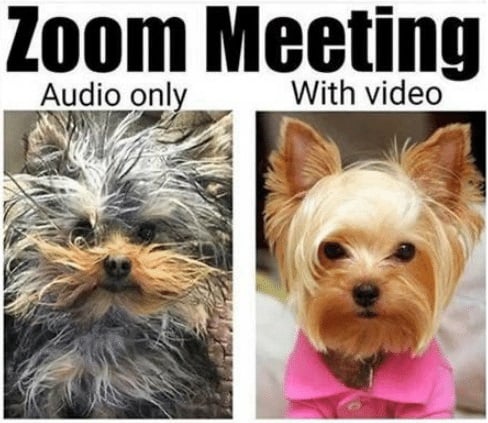
It’s Tuesday morning and you’ve got a big meeting coming up first thing at 9 AM. A prospect is not only super interested in what you have to offer, but they’re bringing along some of their key decision-makers to the meeting as well, so it's crucial that you make a great impression.
But later, you find that no one has their cameras on during the meeting. Half of the people there are muted anyways.
As you present to them, you stumble a little bit while critically thinking to yourself – do they seriously have an interest in what I have to offer to them? The emails before the meeting were spectacular. But now you’ve got a cloud of doubt over the whole deal because they had their cameras off.
Cameras on or off, both can have pros and cons to the situation that you’re in. Maybe you’re having a bad day and forgot a hair tie, or you simply don’t have a camera.
But if you don’t have a camera to begin with, you’re missing out on some fundamental benefits.
So Why Is Having a Camera Important?
Research on effectiveness of virtual meetings has been a focus of organizational communication studies now that the corporate norm is hybrid work.
While we’ve realized negative terms like “virtual meeting fatigue” this decade, understanding success to virtual meetings has been crucial to the health of several businesses.
-1.jpg?width=495&height=418&name=me%20with%20my%20camera%20on%20alt%20(add%20teams%20pictures)-1.jpg)
The main takeaway here is having a camera feed boosts connection, which makes the meeting seem much more natural. Here’s three reasons why:
Camera feeds allow for enhanced engagement.
When individuals have their cameras on during virtual meetings, they are more likely to feel accountable and engaged in the conversation. This can lead to increased participation and a more productive meeting overall.
On the other hand, when cameras are off, participants may feel less invested in the meeting, leading to decreased participation and potentially missed opportunities for collaboration and problem-solving.
Non-verbal communication is highlighted during video feeds.
It goes back to the old saying - two senses are much better than having one!
Studies have shown that nonverbal cues, such as facial expressions and body language, play a significant role in communication and can have a powerful impact on how individuals perceive one another.
To add onto this, 90% of the information processed by the brain is visual. Without a camera, a participant can lose nonverbal cues that eliminate better context and understanding of the other party's speech.
When participants have their cameras on during virtual meetings, they are more likely to pick this up, leading to increased engagement and a stronger sense of connection between participants. This can also be especially important in situations where first impressions matter, such as during job interviews or client meetings.
Having your camera on during remote sales meetings improves sales.
A study by Gong.io from 2018 found that sales were closed 41% more if they used webcams during the buyer’s journey.
When participants can see each other during the meeting, it can lead to a more natural and authentic conversation.
Additionally, adding onto the main point above, having a camera on can help the salesperson pick up on nonverbal cues from the client, such as facial expressions and body language, that can provide valuable insight into their level of interest and engagement.
This can help the salesperson tailor their pitch and respond to the client's needs more effectively, ultimately increasing the likelihood of a successful sale.

Do I Always Need To Have A Camera On?
NO! Cameras aren’t always essential. If you’re attending something like a lecture, it might be seen as better to reduce attention from yourself to give more to the speaker.
Especially in long meetings where you don’t have to give input, leaving your camera on for long periods of time can create “Zoom fatigue” that intensifies as the meeting goes on. You shouldn’t be expected to use your camera all the time – but when you need it, it only makes the interaction so much better.
But keep in mind that “Zoom fatigue” can be reduced if the entire team uses the same camera. Imagine having your whole team meet in front of one camera that picked up everyone equally instead of a table full of laptops. There’s better solutions that lead to better situations, and as an A/V integrator, we’d be more than happy to help if you’re looking at a fresh system.


